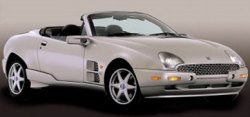  Introduced in the 1996 Geneva motor show, Bigua was arguably the last new De Tomaso launched before the company ceased production. However, Bigua was never produced under the name of De Tomaso. Instead, most people knew it as “Qvale Mangusta”….. In the early 90s, Alejandro De Tomaso was troubled by health problem, leaving his De Tomaso-Maserati business largely ignored. Maserati chief engineer Giordano Casarini came up an idea of building a new sports car. Having inspired by TVR, Casarini designed a simple FR chassis based on a Ford V8. It has a very special retractable roof, which could transform the car from coupe to convertible or Targa. The car was shown in the 1996 Geneva motor show and caught the attention of the Qvales family, the US importer for many European prestige cars. Qvale provided funding to develop the show car into production car, which would be called “De Tomaso Mangusta” instead. It also built a new assembly plant in Modena as it anticipated strong demand form the US market. In return, Qvale got the production and worldwide marketing right of the car (excluding for Italy and UK). However, as De Tomaso’s management vacuum didn’t improve, Qvale finally took over the project together with Giordano Casarini. When the car went into production in 2000, it was renamed to Qvale Mangusta. Now it is no longer a De Tomaso. Qvale Mangusta had a composite body and a box-section steel chassis riding on double-wishbones suspensions all round. Following the tradition of De Tomaso, it employed a stock Ford V8 and transmission, this time both come from Mustang Cobra. The stock V8 inherently complied with Federal emission standards. Qvale also engineered the car to satisfy Federal safety laws. The angular exterior styling was penned by Marcello Gandini, the father of Lambo Miura, Countach and various Maseratis. An evidence was given by the angular shape of rear wheelarches, which was the signature of Gandini. Nevertheless, it was not the best design from Gandini, as the profile looked too fat and the bonnet looked too high (due to the tall Mustang V8). The headlamps, grilles and front bumper also looked odd. On the plus side, the new Mangusta had a unique feature - a flexible roof panel which could be completely stored or partly stored, thus the car could be either a Coupe, a Targa or a Roadster. Brilliant. The rear window and B-pillar were electric-activated, but the roof required 100% manual operation. Well, I’m not going to expect De Tomaso could afford the development of a SLK-style electric mechanism.  Although the new Mangusta was not very long, it was extremely wide and heavy. Its 2670mm wheelbase was also among the longest for a 2-seater. That enabled the big V8 to be positioned virtually completely behind the front axle and resulted in a perfect front-to-rear weight distribution. The Mustang V8 displaced 4.6 litres and produced 320 hp as in Mustang Cobra. Power was delivered linearly across the rev range rather than concentrated on the bottom end. Although the Mangusta was 100 kg lighter than a Mustang, it still weighed a rather hefty 1450 kg. The Borg-Warner 5-speed manual also deteriorated the performance by its widely separated ratios. Shift quality was not as good as European standard too. As a result, 0-60 mph required about 6 seconds. Handling was pretty good. In terms of specifications, it was hard to be criticized: a very rigid chassis, 50-50 weight distribution, all double wishbones suspensions, grippy tires and strong Brembo brakes. It rode well yet provided excellent body control. There was no understeer expected for a front-V8 sports car, just very neutral except coming near limit. There was power oversteering to play with. Braking was powerful and progressive. On the negative side, the Ford-sourced power steering was too light for European driving style, and lacked a sharp turn-in feeling. Otherwise, the Mangusta was well balanced and competent to drive fast without asking for too much effort and attention. It was not as focused or as exciting as many European sports cars, but Qvales’ eyes were always looking to the US market, where people required a bit more driving ease instead of driving fun. Apart from engine, drivetrain and steering, Qvale Mangusta also employed a lot of Ford components in the cabin - the whole dashboard was supplied by Ford’s component division Visteon with all the switch gears and equipment pre-installed. Door handles and other controls also came from Ford’s parts bin. Therefore, the interior looked very much like a Ford Mustang. There were almost all equipment you needed - air-con, power windows, ABS and leather seats. Qvales expected to produce 900 Mangustas in 2001, but that did not come true. Market reaction to the car was poor, probably due to its mild performance, weird look and cheap interior, or its general inability to match Porsche 911. In mid-2001, Qvale sold its sports car making business, including the Modena factory, to MG Rover. The latter reskinned and reengineered the Mangusta into MG SV (project X80), which was just another flop. |